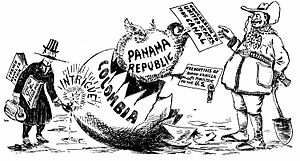Hay–Bunau-Varilla Treaty facts for kids

A cartoon from 1903 about the treaty
|
|
| Type | Bilateral treaty |
|---|---|
| Signed | 18 November 1903 |
| Location | Washington, D.C., USA |
| Original signatories |
|
| Ratifiers |
|
The Hay–Bunau-Varilla Treaty (in Spanish: Tratado Hay-Bunau Varilla) was an important agreement signed on November 18, 1903. It was made between the United States and Panama. This treaty created the Panama Canal Zone and allowed the United States to build the Panama Canal. The treaty is named after its main negotiators: Philippe-Jean Bunau-Varilla, who was a French diplomat representing Panama, and John Hay, who was the United States Secretary of State.
Contents
Building the Panama Canal
Before this treaty, a French company tried to build a canal in Panama. Ferdinand de Lesseps, who built the Suez Canal, led this effort. However, his company failed. Philippe-Jean Bunau-Varilla was involved in this first attempt.
After the French company failed, Bunau-Varilla became a major owner of a new company. This company still had the right to build a canal in Panama. Even though he was not Panamanian, Bunau-Varilla helped Panama gain independence from Colombia. This happened just two weeks before the treaty was signed. The United States bought the rights and property of Bunau-Varilla's company for $40 million. This was part of the Hay–Bunau-Varilla negotiations.
What the Treaty Said
The Hay–Bunau-Varilla Treaty had many articles, or sections, that explained the agreement between the United States and Panama. Here are some of the most important points:
- Panama's Freedom: The United States promised to protect Panama's independence.
- Land for the Canal: Panama gave the United States the right to use land for the canal. This included the area where the canal would be built and nearby land needed for construction. It also included islands within the canal zone.
- U.S. Control: The United States gained full control over the Canal Zone. This meant the U.S. could act as if it were the ruler of that land. Panama could not use its own ruling powers there.
- Water Use: The U.S. could use lakes, oceans, and other waters around Panama for shipping related to the canal.
- Canal Services: Panama gave the U.S. the only right to build and run any communication systems for the canal.
- Property Rights: Panama gave the U.S. all rights to the property of the old French canal company and the Panama Railroad Company.
- No Extra Fees: Neither country would charge extra fees for ships using the canal. This included tolls, taxes, or port charges.
- Payments to Panama: The United States agreed to pay Panama $10 million in gold right away. Nine years after the canal opened, Panama would also receive an extra $250,000 each year.
- Neutral Canal: The canal and its entrances would always be neutral. This meant it would be open to all ships under the treaty's rules.
- Panama's Access: Panama's own ships and troops could use the canal at any time without paying fees.
- Protecting the Canal: If needed, the United States had the right to use its police and military forces to protect the canal.
- Land for Bases: Panama agreed to sell or lease land to the United States for naval or coaling stations. These were important for protecting the canal.
Treaty Details and Impact
The treaty was negotiated in Washington, D.C., and New York City. It gave the United States rights to a canal zone that stretched five miles on each side of the canal route forever. Panama received the initial $10 million payment and an annual payment of $250,000. Panama did not become a colony of the United States. Instead, the Hay–Bunau-Varilla Treaty gave the U.S. control only within the Canal Zone.
Later Conflicts and Changes
This treaty caused many disagreements between Panama and the United States for a long time. The Canal Zone became a separate area from the rest of Panama. It had its own rules and was different socially.
The conflict became very serious on January 9, 1964. Protests about who should control the Panama Canal Zone turned violent. This happened after a Panamanian flag was torn during a disagreement between Panamanian students and Canal Zone Police officers. The students wanted the Panamanian flag to fly next to the U.S. flag. U.S. Army units had to step in to stop the violence. After three days of fighting, about 22 Panamanians and four U.S. soldiers died. This day is now known in Panama as Martyrs' Day.
The events of January 9 were a big reason why the U.S. decided to negotiate new treaties in 1977. These were called the Torrijos–Carter Treaties. They finally ended the Hay–Bunau-Varilla Treaty. These new treaties allowed the Canal Zone to slowly be given back to Panama. Full control of the Panama Canal was handed over to Panama on December 31, 1999.
See also
 In Spanish: Tratado Hay-Bunau Varilla para niños
In Spanish: Tratado Hay-Bunau Varilla para niños

